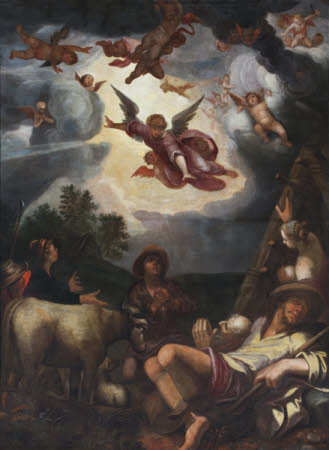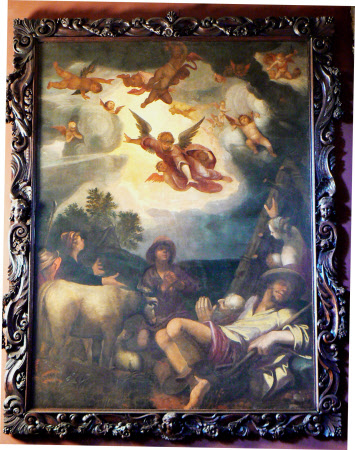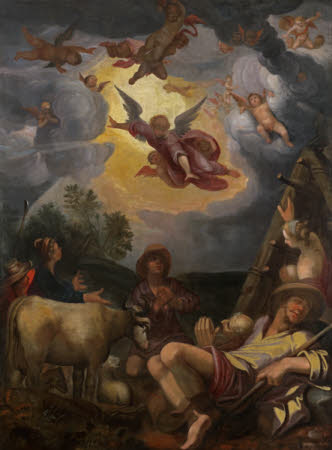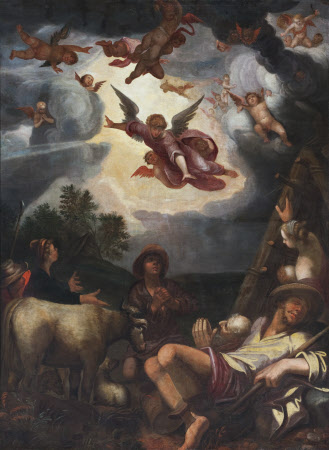The Angel appearing to the Shepherds
after Abraham Bloemaert (Gorinchem 1566 – Utrecht 1651)
Category
Art / Oil paintings
Date
1660 - 1677 (before)
Materials
Oil on canvas
Measurements
2032 x 1499 mm (80 x 59 in)
Place of origin
England
Order this imageCollection
Ham House, Surrey
NT 1139663
Caption
The subject of the ‘Annunciation to the Shepherds’ reached the height of its popularity in the Netherlands at the end of the sixteenth century and in the early part of the seventeenth century. Numerous interpretations of the subject were produced as paintings and drawings, and these images were often translated into printed form. Such prints were distributed widely throughout Europe, facilitating the rise of subject’s appeal in Britain. Abraham Bloemaert (who from 1593 ran a workshop in Utrecht) was among the most prolific producers of paintings on this theme. Jan Saenredam’s 1599 engraving of the annunciation is inscribed as being after a painting by Bloemaert – the original of which is now lost. The present painting is clearly based on Saenredam’s print - although some of the more detailed elements are omitted, the overall composition corresponds closely. The unknown artist’s rather stark handling of light and shade, especially in areas of drapery, further suggests that this is a painting copied from a monochrome graphic source with a high contrast between different gradations of tone. Several other copies of Bloemaert's painting are known and there are also some related drawings in the British Museum.
Summary
Oil painting on canvas, The Angel appearing to the Shepherds, after Abraham Bloemaert (Gorinchem 1566 – Utrecht 1651), circa 1670. A painted scene of the Annunciation, with a reclining shepherd in the foreground, a cow to the left and several other rustic figures looking upwards towards the figure of the angel, who appears through a breakage in the clouds, surrounded by other celestial figures and putti. Based on Jan Saenredam’s 1599 engraving after Bloemaert's original painting (now lost). The frame is of the 1670s similar to that on John Michael Wright's Charles II in the National Portrait Gallery, London.
Provenance
Probably part of William Murray's collection; in 1677 inventory, 1679, 1683 inventories and thence by descent until acquired in 1948 by HM Government when Sir Lyonel, 4th Bt (1854 – 1952) and Sir Cecil Tollemache, 5th Bt (1886 – 1969) presented Ham House to the National Trust, and entrusted to the care of the Victoria & Albert Museum, until 1990, when returned to the care of the National Trust, and to which ownership was transferred in 2002 acquired in 1948 by HM Government when Sir Lyonel, 4th Bt (1854 – 1952) and Sir Cecil Tollemache, 5th Bt (1886 – 1969) presented Ham House to the National Trust, and entrusted to the care of the Victoria & Albert Museum, until 1990, when returned to the care of the National Trust, and to which ownership was transferred in 2002
Credit line
Ham House, The Dysart Collection (purchased by HM Government in 1948 and transferred to the National Trust in 2002)
Makers and roles
after Abraham Bloemaert (Gorinchem 1566 – Utrecht 1651) , artist previously catalogued as attributed to Alonso Cano (Granada 1601 - Granada 1667), artist
References
Roethlisberger 1991 Marcel Roethlisberger, Abraham Bloemaert, 1991 Simon 2014, Jacob Simon (ed. Sarah Okpokam), Picture Frames at Ham House, National Trust, 2014, p. 13 Prized Possessions: Dutch Paintings from National Trust Houses (exh. cat.), Holburne Museum, Bath 25 May - 16 Sep 2018; Mauritshuis, The Hague, 11 Oct 2018 - 6 Jan 2019; Petworth House, West Sussex, 26 Jan - 24 Mar 2019., p. 59



